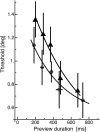Spatial position information accumulates steadily over time
- PMID: 24259564
- PMCID: PMC6618801
- DOI: 10.1523/JNEUROSCI.1864-13.2013
Spatial position information accumulates steadily over time
Abstract
One of the more enduring mysteries of neuroscience is how the visual system constructs robust maps of the world that remain stable in the face of frequent eye movements. Here we show that encoding the position of objects in external space is a relatively slow process, building up over hundreds of milliseconds. We display targets to which human subjects saccade after a variable preview duration. As they saccade, the target is displaced leftwards or rightwards, and subjects report the displacement direction. When subjects saccade to targets without delay, sensitivity is poor; but if the target is viewed for 300-500 ms before saccading, sensitivity is similar to that during fixation with a strong visual mask to dampen transients. These results suggest that the poor displacement thresholds usually observed in the "saccadic suppression of displacement" paradigm are a result of the fact that the target has had insufficient time to be encoded in memory, and not a result of the action of special mechanisms conferring saccadic stability. Under more natural conditions, trans-saccadic displacement detection is as good as in fixation, when the displacement transients are masked.
Figures





Similar articles
-
Saccadic suppression of displacement: influence of postsaccadic exposure duration and of saccadic stimulus elimination.Vision Res. 1990;30(6):945-55. doi: 10.1016/0042-6989(90)90060-x. Vision Res. 1990. PMID: 2385932
-
Saccadic suppression relies on luminance information.Psychol Res. 1995;58(3):163-8. doi: 10.1007/BF00419631. Psychol Res. 1995. PMID: 8570784
-
The spatio-temporal tuning of the mechanisms in the control of saccadic eye movements.Vision Res. 2006 Oct;46(22):3886-97. doi: 10.1016/j.visres.2006.06.012. Epub 2006 Aug 1. Vision Res. 2006. PMID: 16879855
-
Saccade-contingent spatial and temporal errors are absent for saccadic head movements.Cortex. 2005 Apr;41(2):205-12. doi: 10.1016/s0010-9452(08)70895-5. Cortex. 2005. PMID: 15714903 Clinical Trial.
-
Trade-off between spatiotopy and saccadic plasticity.J Vis. 2014 Oct 27;14(12):28. doi: 10.1167/14.12.28. J Vis. 2014. PMID: 25349269
Cited by
-
Transsaccadic visual perception of foveal compared to peripheral environmental changes.J Vis. 2021 Jun 7;21(6):12. doi: 10.1167/jov.21.6.12. J Vis. 2021. PMID: 34160578 Free PMC article.
-
A review of interactions between peripheral and foveal vision.J Vis. 2020 Nov 2;20(12):2. doi: 10.1167/jov.20.12.2. J Vis. 2020. PMID: 33141171 Free PMC article. Review.
-
Buildup of spatial information over time and across eye-movements.Behav Brain Res. 2014 Dec 15;275:281-7. doi: 10.1016/j.bbr.2014.09.013. Epub 2014 Sep 16. Behav Brain Res. 2014. PMID: 25224817 Free PMC article.
-
Visual mislocalization during saccade sequences.Exp Brain Res. 2015 Feb;233(2):577-85. doi: 10.1007/s00221-014-4138-z. Epub 2014 Nov 5. Exp Brain Res. 2015. PMID: 25370348 Free PMC article.
-
Visual temporal integration windows are adult-like in 5- to 7-year-old children.J Vis. 2019 Jul 1;19(7):5. doi: 10.1167/19.7.5. J Vis. 2019. PMID: 31287859 Free PMC article.
References
Publication types
MeSH terms
LinkOut - more resources
Full Text Sources
Other Literature Sources
Research Materials
